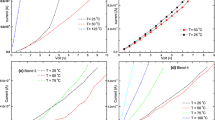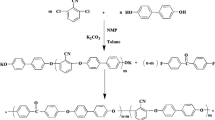Abstract
Four composites of PHB, with varying amounts of PANI, carbon black (CB), and a tributyl O-acetylcitrate were prepared by solvent casting and then melted to form films by hydraulic hot press. The morphology, thermal properties, and electrical conductivity of PHB were studied by TEM, DSC, four-point probe, LCR bridge, FT-IR, and WAXD. The values of ε′ and ε″ had a higher values with the addition of PANI/CB compared to pure PHB. The conductivity increased from 10−15 to 10−6 S cm−1 and increased with raised the temperature similar semiconductor. TEM showed good dispersion of PANI and CB and no agglomerations in the PHB matrix. The new PHB composites can be applied in the medical and electronics industries in the near future.











Similar content being viewed by others
References
Herr DE, Nikolic NA, Schultz RA (2001) Chemistries for high reliability in electronics assemblies. High Perform Polym 13:79–100
El-Hadi A, Schnabel R, Straube E, Mueller G, Riemschneider M (2002) Effect of melt processing on crystallization behavior and rheology of poly(3-hydroxybutyrate) (PHB) and its blends. Macromol Mater Eng 278:363–372
El-hadi AM, Al-Jabri FY (2016) Influence of electrospinning parameters on fiber diameter and mechanical properties of poly(3-hydroxybutyrate) (PHB) and polyanilines (PANI) blends. Polymers 8(97):1–13
Ando Y, Fukada E (1984) Piezoelectric properties and molecular motion of poly(β-hydroxybutyrate) films. J Polym Sci Polym Phys Ed 22:1821–1834
Tajitsu Y, Sukegawa M, Kikuchi M, Sudo N, Kudo M, Masuko T (2003) Piezoelectric poly-l-lactic acid film prepared by a new method. Jpn J Appl Phys 42:6172–6175
Sugita A, Mitsubayashi M, Tasaka S (2006) Electric activity in rigid rod-like polymer, poly(β-hydroxybutyrate). Polymer 47:5141–5144
Llorens E, Armelin E, del Mar Pérez-Madrigal M, del Valle LJ, Alemán C, Puiggalí J (2013) Nanomembranes and nanofibers from biodegradable conducting polymers. Polymers 5:1115–1157
Sun KH, Liu Z, Liu C, Yu T, Shang T, Huang C, Zhou M, Liu C, Ran F, Li Y et al (2016) Evaluation of in vitro and in vivo biocompatibility of a myo-inositol hexakisphosphate gelated polyaniline hydrogel in a rat model. Sci Rep 6:23931
De Paoli MA, Waltman RJ, Diaz AF, Bargon J (1984) Conductive composites form poly(vinyl chloride) and polypyrrole. J Chem Soc Chem Commun 15:1015–1020
Eisazadeh H (2007) Copolymerization of aniline and vinyl acetate by using various surfactants in aqueous media. J Vinyl Addit Technol 13:229–233
Eisazadeh H, Kavian A (2009) Copolymerization of aniline and styrene using various surfactants in aqueous media. Polym Compos 30:43–48
Cassignol C, Cavarero MA, Boudet A, Ricard A (1999) Microstructure-conductivity relationship in conducting polypyrrole/epoxy composites. Polymer 40:1139
Raja S, Deepa M (2015) Synthesis and characterization of polyaniline-copper(II) oxide nanocomposite by wet chemical route. Indian J Adv Chem Sci 3:198–203
Tsotra P, Friedrich K (2004) short carbon fiber reinforced epoxy resin/polyaniline blends: their electrical and mechanical properties. Compos Sci Technol 64:2385–2391
Saad GR, Ezz AA, Ahmed HA (2015) Cure kinetics, thermal stability, and dielectric properties of epoxy/barium ferrite/polyaniline composites. Thermochim Acta 599:84–94
Chen SA, Fang WG (1991) Electrically conductive polyaniline-poly(vinyl alcohol) composite films: physical properties and morphological structures. Macromolecules 24:1242–1248
Kim SJ, Kim MS, Kim SI, Spinks GM, Kim BC, Wallace GG (2006) Self-oscillatory actuation at constant DC voltage with pH-sensitive chitosan/polyaniline hydrogel blend. Chem Mater 18:5805–5809
Wu CS (2012) Preparation and characterization of an aromatic polyester/polyaniline composite and its improved counterpart. Express Polym Lett 6:465–475
Martins CR, De Paoli MA (2005) Antistatic thermoplastic blend of polyaniline and polystyrene prepared in a double-screw extruder. Eur Polym J 41:2867–2873
Menon R, Yoon CO, Moses D, Heeger AJ, Cao Y (1993) Transport in polyaniline near the critical regime of the metal-insulator transition. Phys Rev B 48:17685–17694
Koul S, Chandra R, Dhawan SK (2001) Conducting polyaniline composite: a reusable sensor material for aqueous ammonia. Sens Actuators B 75:151–159
Pud A, Ogurtsov N, Korzhenko A, Shapoval G (2003) Some aspects of preparation methods and properties of polyaniline blends and composites with organic polymers. Prog Polym Sci 28:1701–1753
Fryczkowski R, Kowalczyk T (2009) Nanofibres from polyaniline/polyhydroxybutyrate blends. Synth Met 159:2266–2268
Hanafy TA, Elbanna K, El-Sayed S, Hassen A (2011) Dielectric relaxation analysis of biopolymer poly(3-hydroxybutyrate). J Appl Polym Sci 121:3306–3313
Cao Y, Smith P, Heeger AJ (1992) Counter-ion induced processibility of conducting polyaniline and of conducting polyblends of polyaniline in bulk polymers. Synth Met 48:91–97
Kremer F, Schönhals A (eds) (2003) Broadband dielectric spectroscopy. Springer, Berlin. doi:10.1007/978-3-642-56120-7, ISBN 978-3-642-56120-7
Harada I, Furukawa Y, Ueda F (1989) Vibrational spectra and structure of polyaniline and related compounds. Synth Met 29:303–312
Lide DR, Frederikse HPR (1993) Handbook of chemistry and physics, vol 9. CRC Press, Boca Raton, pp 153–160
Joo J, Long S, Pouget MJP, Oh EJ, MacDiarmid AG, Epstein A (1998) J Charge transport of the mesoscopic metallic state in partially crystalline polyanilines. Phys Rev B 57:9567–9580
El-Hadi AM (2013) Influence of microcrystalline cellulose fiber (MCCF) on the morphology of poly(3-hydroxybutyrate) (PHB). Colloid Polym Sci 291:743–756
Author information
Authors and Affiliations
Corresponding author
Ethics declarations
Conflict of interest
The authors declare no conflict of interest.
Rights and permissions
About this article
Cite this article
El-hadi, A.M., Al-Jabri, F.Y. & Altaf, W.J. Higher dielectric properties of semiconducting biopolymer composites of poly(3-hydroxy butyrate) (PHB) with polyaniline (PANI), carbon black, and plasticizer. Polym. Bull. 75, 1681–1699 (2018). https://doi.org/10.1007/s00289-017-2118-8
Received:
Revised:
Accepted:
Published:
Issue Date:
DOI: https://doi.org/10.1007/s00289-017-2118-8




